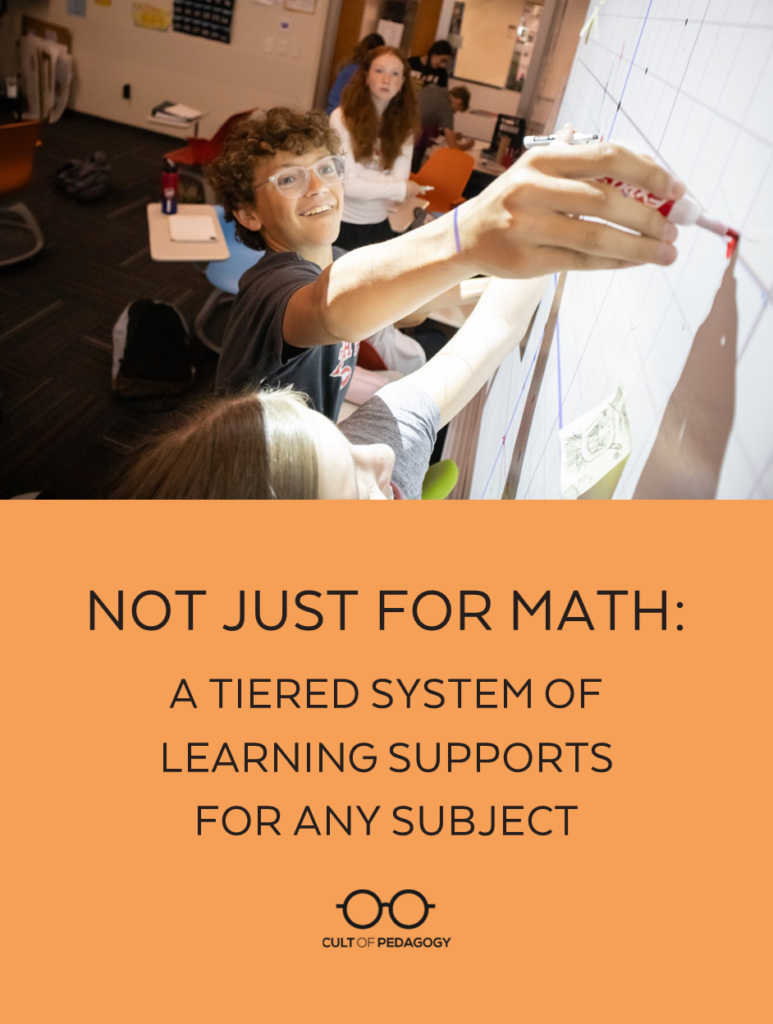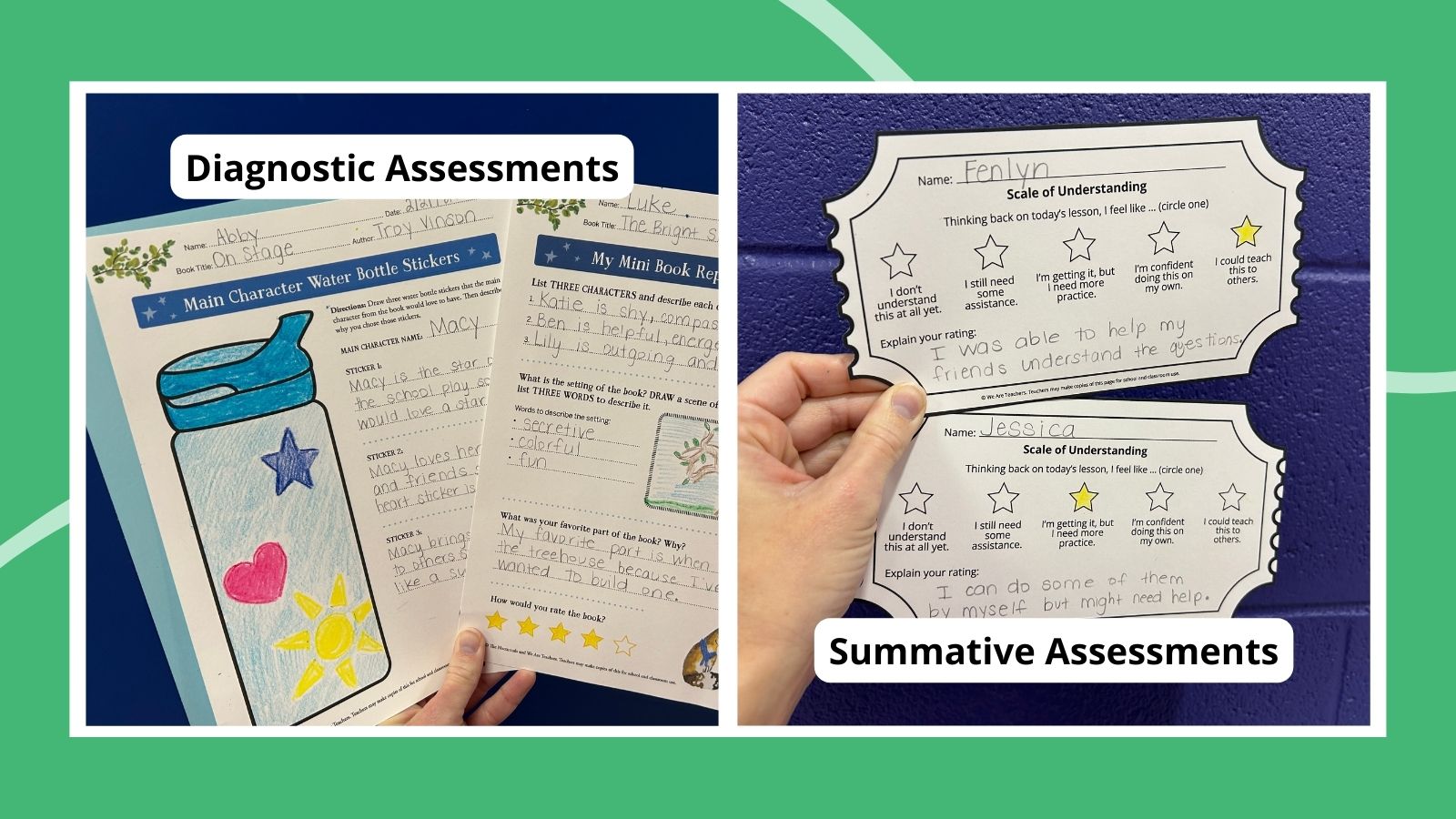Listen to the interview with Sarah Riggs Johnson and Nate Wolkenhauer:
Sponsored by Studyo and Scholastic Magazines+
This post was co-written by Nate Wolkenhauer.
This isn’t really about math. Well, it is, but you could apply it to any subject area. I teach in a small 6-12 independent school with my colleague and friend, Nate Wolkenhauer. Nate teaches Pre-Algebra and Algebra 1 to 6th, 7th, and 8th graders. I am a learning and behavioral specialist. Nate and I collaborate regularly to support students as math learners, and together we’ve developed a kind of system of strategies — some that apply to all students, others only needed for a select few.
You could think of our model as a pyramid, a little bit like the Multi-Tiered System of Supports you may already be familiar with. The first four strategies — the base tiers — are broad and describe how Nate builds a foundation for all students to feel supported and engaged. The last few narrow to a point representing just a small percentage of students who struggle with math. The lines between the “tiers” don’t really exist for us though: The strategies build on each other and spiral back down, mutually reinforcing student learning and growth and empowering all kinds of students to learn math. And we believe they would work in any subject area.
Here we’ll take turns talking about each strategy, and how each of us contributes to its success.
Tier 1: No-Pressure Relationships
Nate (Generalist)
The bottom layer — the foundation upon which everything else is built — is what I have come to think of as no-pressure relationships. These are developed slowly, over time, and although they have a positive impact on learning, they really have nothing to do with academics.
Early in my career, I had a student named Shawn who had a tough time at school. He found little success in academics, had difficulty controlling his anger, and struggled to form relationships with teachers and other kids. It was not uncommon for Shawn to throw chairs, push over desks, or shout “colorful language” at his peers and teachers.
When Shawn would scream at me, I would talk in a hushed tone. The louder he got, the more quietly I spoke. I removed him from situations that were agitating and allowed him to yell at me without taking it personally. When he had calmed down, I would have a real conversation with him. I wouldn’t point blame or send him to the office; instead, I would allow him to talk out what he was feeling, re-evaluate how he reacted, and create a plan for the next time he felt upset. I began to praise Shawn for any little behavioral accomplishment. If he came to class and sat in his chair, I’d say, “Dude.. you’re awesome. Thank you for doing exactly what you’re supposed to be doing.”
I also kept an eye on Shawn during recess. Some days he would join a game of football; other days he would hang out alone. On those days, I would go over and give him some attention. When he questioned me, I would say things like, “Nah, I’d rather just hang out and talk with you today.” I tried hard to never make him feel like a burden. Some days we would talk. Some days I would just say, “Hey. You mind if I join you? Or would you rather just have some you time,” and he would opt to be by himself. I tried my best to create a no pressure relationship.
After the first month of school, the outbursts were less frequent and less severe. Shawn would sometimes have lunch with me; he’d tell me about family, about his weekend and his friends. As he got more comfortable with me, he began to take more risks academically. He knew that if he made a mistake with a math problem, I wouldn’t be disappointed. I’d be genuinely proud of him for putting forth the effort.
Sarah (Specialist)
I find it hard to talk about how to support students with any subject without the foundation of building relationships. We are at this pivotal point where for all income levels, and all types of kids, building relationships has never been more important. We spend so much time on our screens that kids (and let’s be honest, adults) are aching for them, even when they don’t know it.
Nate has a hundred stories to tell like this one because he genuinely likes connecting with his students. Asking him to describe how he builds relationships with students is a bit like asking a fish to describe water. We can all be tired and dragging around the staff table in the morning, sipping our coffee, but when the kids walk into an area we call “the Hub,” Nate is on his feet, high-fiving kids and asking about lacrosse games and chorus concerts and broken arms and little brothers.
In my work with kids, if I’m going to get a 12-year-old to talk about something they feel vulnerable about — not reading fluently, failing the test, not understanding the homework — then I need to be both vulnerable and honest with them. I also pay attention to what lights up their faces, and will often research their interests so that I can ask them questions later! This takes time, energy, and effort — and sometimes that detracts from the time we have to explain a math strategy, but the emotional investment pays off. Kids learn better from teachers that they feel “get” them and like them.
Tier 2: Stand On Your Chair
Nate
I am a fidgety person. I’m the guy standing in the back of the faculty meeting because I cannot physically sit for a full hour. So I am hyper-aware of how long my students are sitting. For me, movement matters.
In 2016, I started encouraging my students to stand on their chairs when they were addressing the class. I told them it was so they would be able to command attention from their peers — so they could get used to standing and speaking in front of a crowd. In reality, standing on chairs is different and weird and fun. The kids are getting up and moving, and they’re excited to do something that is typically frowned upon in classrooms.
Purposeful movements can be even more impactful. If I sing the “Macarena,” what might you start doing? What about the YMCA? When I link movements to specific math vocabulary, it gives students another toolkit to pull from. When a student gets stuck on a problem, I can just ask, “Show me a unit rate,” and they will hold up a finger on one hand and place their other hand above it, creating a fraction bar. Then the lightbulb goes off. “Ohhhhhhh. That’s right. Now I remember.” For almost every chapter, we learn movements for different concepts or vocabulary. Sometimes they are dance moves with music, other times we just play Simon Says (which, even in 8th grade, is still a favorite of my students).
When I teach unit rates, I transform my room into a grocery store. I line up tables and fill them with various types of food. I then place prices for different brands of the same item using different unit rates. For example, Grade A eggs may cost $6.36 per dozen while Publix brand eggs may cost $12.78 per 2 dozen. Students run around collecting two items that are the same to find the best deal. They’re moving, they’re finding unit rates in a real-world situation, and they’re invested in the math.
I try to include games in lessons as often as I can. When teaching ordered pairs on a four-quadrant coordinate plane, we play Quadrant Quest: Using painter’s tape, we create a giant coordinate plane on the classroom floor. In groups of 4, students are given a stack of ordered pairs. One student starts at the origin and their teammates describe how they should move. If the ordered pair is (-4,5), the students would shout, “Move four spots to the left and five spots up!” The student moving needs to then say the ordered pair. The team that gets the most pairs in 90 seconds wins.
Sarah
We know enough about neurodiversity to know that the “sitting still and listening” way of doing school doesn’t work well for many students. By using “multiple means of engagement,” students who are not typically very engaged or motivated dial into the lesson. Adding movement, context, and an element of play to math classes helps kids learn, but what I even like to think about is the later effects. You take a student who has struggled with math and “doing school” in the past — maybe so much that they have anxiety about being in that class and identify as “bad at math.” Now in math class, they are trying to solve problems, but they are also moving and smiling and even laughing (even if it’s just at how goofy Mr. Wolkenhauer is). Their brain is releasing dopamine and rewiring itself to feel differently in that class. Students with learning differences who work with me end 7th grade saying math “used to be” their worst subject. This teaches them that they can learn anything.
Tier 3: “My job. Not your job.”
Nate
On the first day of school every year, I have students act out this scenario. I start by bringing up two students. I ask student 1 to say, “I can’t believe you don’t know that!” I then reprimand that student. I put on my sternest face and say something along the lines of “Absolutely not. That’s unacceptable.”
Next, I ask student 2 to say, “Yeah. That’s unacceptable.” I then turn to student 2 and, using the same stern facial expression, I say, “My job. Not your job.”
I explain to my kids that they need to trust me to handle situations that are inappropriate, regardless of who is acting inappropriately. I will stand up for you, but the second you make a snide remark or giggle at someone else’s expense, I will call you out. There are no favorites.
This creates an environment where students know it is unacceptable to make anyone feel small or ostracize someone who makes a mistake. They quickly learn that I will not let any unkind comment or eye roll slide, which creates a classroom environment where students are more likely to take risks. They are more likely to raise their hand and offer up an answer. They are more likely to share their thoughts about what they might already know about a topic they haven’t yet learned.
Sarah
If you teach middle school, you already know about math anxiety. The fear of getting the problem “wrong” starts early. By the time kids are adolescents, anxiety becomes a strong barrier to learning. More than anything, students do not want to mess up in front of their peers.
A kid with a learning difference will be even more worried about saving face and hiding their weaknesses. Answering a question in front of the class activates the same fight or flight response as if a “tiger was in a classroom” (Posey, 2018). Research reliably points to this emotion derailing kids’ ability to learn (Immordino-Yang & Damasio, 2007). Nate combats this by consciously working to build — and maintain — a culture of respect in his classroom. The typical preteen practice of “one-upping” each other becomes uncool. However, his students also learn he does not hold a grudge, because he knows that sometimes the most vulnerable students are the ones making the poor choices. This makes students feel emotionally safe taking risks in the classroom. Showing consideration for how you want students to FEEL while they are learning helps clear away the tigers, so they can focus on the math.
Sarah Riggs Johnson
Nate Wolkenhauer
Tier 4: “High Expectations, Flexible Means”
Sarah
When I support students, I’m very conscious of preserving the integrity of the test or assignment. I don’t want to “over-help” a student for the sake of a good grade when I know they will need the skill in the future. To keep expectations high, I sometimes have to find different avenues for students to access or demonstrate the required skills or knowledge. This principle of “high expectations, flexible means” comes from Katie Novak’s work on Universal Design for Learning (UDL).
Last year, Nate and I both taught David, who has severe dyslexia. (Dyslexia is normally associated with reading difficulty, but math is a symbol system just like written language, so students with dyslexia can also struggle with math.) David also happens to be a charming, hard-working, genuine student, the kind you would bend over backward to help. So when it came time to grade his assessments, it was easy to want to overlook the negative signs he missed. We decided together, though, that it did not serve David to give him those points. He could use a calculator during tests, but he had to learn a strategy for tracking those negative signs. They are essential to the problem, and for his computation skills going forward. High expectations, flexible means. Dock him the points, but give him a way to earn them back.
Nate
Sarah already explained David’s use of a calculator, but perhaps even more importantly, we built him up to feel comfortable and confident using his accommodations. When he missed problems or made the same mistake again and again on tests, we gave him the opportunity to look for those mistakes and celebrated when he was able to find them. When he bombed tests because of errors like missing negative signs, I would mark the problems he missed and allow him to correct them in Sarah’s office for points back. We then sometimes showed him the before and after score to help him understand how putting the extra work in affected his grade. We sometimes would not let him turn a test in until he had checked all his negative signs and reduced fractions on problems #6, #13, #21, etc. We sort of forced him to practice double-checking his work and to learn what kind of errors he was commonly making.
David didn’t need us to throw him some extra points for his effort. He needed us to be there for him, build him up, and help him reach his goals. Getting an “A” on a test is so much more satisfying when you have put in the work.
Tier 5: Learning Out Loud
Nate
My classroom is loud because of the constant conversation I ask my students to have with one another. I encourage my kids to “talk it out” and use their words to describe their thinking.
Sarah
Doing math out loud can also help students learn to generalize the language of math — words like equation, variable, inequality, and perpendicular are tricky for some students. The repetition helps them visualize and build schema for new vocabulary.
Nate
So why would I take talking away for tests? Freddy is a student who works tremendously hard. He asks questions when concepts are unclear and, when talking about math, is able to express his thinking clearly. The more he talks through the math and gets validation for his thinking, the better he can work through the concepts. But when it comes to test time, Freddy struggles to have those conversations in his head and tends to freeze up. He wants to talk through concepts or receive validation during the test but feels uncomfortable in a room full of his peers. For his most recent test, I asked how he would feel trying to take it with Sarah in her office. He agreed and scored a 98%. Sarah did not provide him with answers or explain how to complete problems, but she was there to validate his thinking. Freddy just needed space to talk himself through the test.
Sarah
Talking through tests also helps students stay focused. Eli is the type of kid who bounces. He goes for every fidget I have in my office. He twirls his pencil around the room and prefers my stand-up desk. Even when he comes to my quiet office for math tests, if left to his own thoughts, he ruminates about big numbers and spends 20 minutes testing the limits of the calculator. Students like Eli who have ADHD have difficulty with math not because they don’t understand it conceptually, but because they struggle to sustain focus or organize themselves around multi-step problems. When I leave Eli to his own devices to finish a test, he will be on problem 2 after 40 minutes.
What helps him is to do math out loud. For a geometry test, I start with “Eli, let’s go. Point to the formula you think you should use for this problem. What’s the question asking for — circumference, area, or volume? — and talk me through it.” Hearing himself talk through problems is enough stimulation that he stays focused through even the worst of surface area problems!
Tier 6: Test Pulling
Nate
When I was in high school, I cheated on a social studies test. I sat next to the bookshelf and placed my notes on a shelf in view. About halfway through the test, my teacher came over, took my test, and took the notes off the shelf. Of course, I denied it. I was a pretty good student but was not prepared for the test and had an immense fear of failure. This was an isolated scenario for me, but some students experience this feeling of defeat over and over, not because they didn’t prepare, but for other reasons out of their control — anxiety, misread instructions, and so on.
Students who regularly do poorly on tests do not want to feel that failure. At what point should our perspective adjust to worry more about the child as opposed to the grade? I’m not saying we need to just reward a child who is failing to make them feel good. But there are situations where helping a child find some success on tests may be more important to them long-term than letting them fail again on their own.
Sarah
Nate lets kids do homework with him after school. He also lets me do homework with kids in my office. And for students who don’t perform on assessments, he lets me help them during tests. Never had I ever met a teacher who so easily let go of the sanctity around tests. When I worried that I may be helping a student too much, he’d reply with, “That kid really needs a win right now.”
We trap ourselves and kids into cycles of failure when we decide that tests need to be big, scary summations of progress and knowledge instead of a learning experience in themselves. Instead of letting a student fail another one, Nate let me ask the question — what if we helped her learn how to get better at taking math tests?
Because students are the most anxious about doing well during a test it can make it an ideal time for me to work with them. They usually are very dialed in because they want to make a good grade. Unlike when I meet with them after school, I don’t have to compete with the video game they’d rather be playing — that’s not an option during a test.
During a test, I use a strategy that I call, for lack of a better name, “pulling.” I usually start by explaining that I cannot tell them the answers. Nor can I teach them how to do the problem, because it’s a test. Their math teacher has to be able to see what they know and how they tackle problems. I explain that what I will do is “pull” what they already know out of them. I do this by asking a lot of questions.
What information does the problem give us?
What is it asking for?
How do you think we could set this one up?
What do you think you should do first?
What kind of shapes do you see here?
Didn’t Mr. Wolkenhauer teach you all a song about this?
All questions are designed to pull out what they know but also to model a routine for what to do when they get stuck.
For students who struggle to generalize a strategy that worked well for them in the past, I will also casually say, “Oh, I remember that last time on the midpoint quiz, it helped when you first wrote your formulas on the top of your page…” or “I noticed that it helped you on the homework when we labeled the x and y axis.”
When problems are broken down this way, 90% of students who come up for their tests start recalling what they learned and practiced in class. They do not need me to teach them anything! They just need me to ask the right questions, maybe validate their thinking, and then get out of their way.
Tier 7: Strategies for the 10%
Sarah
For a smaller group of students, the first six tiers are not quite enough. We have found that these additional strategies can help:
Highlighting, lined paper, and color-coding: Students who struggle with executive functioning often hit a wall when they’re first learning algebra. Usually they understand the concepts, but they struggle with the organization. You need to accurately copy the problem and track steps on both sides of an equation. You have to notice details like negative signs and hold steps in working memory to remember where you are within a problem. In my office, I might be working on getting them to slow down, write out their work, and track/sequence steps. Highlighting equal signs, learning to solve problems down the page on lined paper (whether it is digital or real paper), and color-coding like terms or important parts of a diagram or figure can be helpful in teaching these students to track steps. For example, when students first learn about coordinate planes, color-coding the x-axis as red and the y-axis as blue and using those colors for values in coordinate pairs can help eliminate confusion about which is which until they get the hang of it.
Manipulatives: When people refer to using “manipulatives” in math, they mean any physical, tangible object that a student can manipulate to learn a math concept. For example, a set of 3D geometric shapes may help a student understand where the base of a pyramid or prism is much faster than a 2D picture of it printed on a worksheet.
Extra work with symbols: Students with dyslexia or other language-based learning differences may struggle with the vocabulary of math, calling an inequality sign by its elementary school name, “the alligator mouth thingy.” Math is a symbol system just like the English language. It has directionality, order (that is NOT always left to right), and a sequence that matters! When you understand that 2x means “2 times (multiplied by) an unknown quantity represented by an x” that means you can read/interpret Algebra! It takes some students longer to learn to read the symbol system of Algebra. I try to be really explicit about this when I work with students. I will say, “So let’s talk about what this symbol means because it can be tricky to know what operation we are supposed to be doing here!”
Limiting options: Math instruction has shifted in the last few decades toward teaching multiple ways of “seeing” and understanding quantity, computation, proportion, and patterns. If you are a parent, you may have noticed that the way your child is learning to solve problems is totally different from the “borrowing” method for multi-digit subtraction that we old folks learned in school. This is because we were not really understanding place value when we only learned “the borrowing trick.” For students with learning differences in math, it can be helpful to start by learning just ONE way to solve. The debate between understanding the deeper meaning of math and learning a process for getting to the right answer is not always something I have time for, depending on the student I am working with. I will often try to solve a problem a couple of ways and have them choose the one they feel most comfortable with — that’s the one we’re going to learn, for now! I don’t want them to get stuck because they could not memorize all 6 different methods for solving.
Calculators: The students whom we struggle most to support in math are the ones who do not have a strong concept of numbers, quantity, and the relationships between numbers. (The label for this is dyscalculia.) Shannon might need to turn to a calculator over and over again to see that 4/1 is just 4. This is not because she didn’t try to memorize her math facts in the third grade or that she isn’t capable of algebraic thinking. The numbers themselves just don’t carry as much meaning for her. But students who truly struggle to understand numeric relationships can still learn higher-level math; just let them use the calculator! It supports their dyscalculia, working memory, and processing speed, but also lets them focus on what the problem is asking for. Problem-solving and reasoning are important beyond math!
References
CAST (2018). Universal Design for Learning Guidelines version 2.2. Retrieved from http://udlguidelines.cast.org
Immordino-Yang, M. H., & Damasio, A. (2007). We feel, therefore we learn: The relevance of affective and social neuroscience to education. Mind, Brain, and Education, 1(1), 3–10. https://doi.org/10.1111/j.1751-228x.2007.00004.x
Novak, K., & Couros, G. (2022). UDL now! : A teacher’s guide to applying universal design for learning. CAST Professional Publishing.Posey, A. (2018). Engage the brain: How to Design for Learning That Taps into the Power of Emotion. ASCD.
Join our mailing list and get weekly tips, tools, and inspiration that will make your teaching more effective and fun. You’ll get access to our members-only library of free downloads, including 20 Ways to Cut Your Grading Time in Half, the e-booklet that has helped thousands of teachers save time on grading. Over 50,000 teachers have already joined—come on in.
The post Not Just for Math: A Tiered System of Learning Supports for Any Subject first appeared on Cult of Pedagogy. This system starts with strategies that work for everyone and narrows to techniques just for those who need the most help.
The post Not Just for Math: A Tiered System of Learning Supports for Any Subject first appeared on Cult of Pedagogy. Instruction, Podcast, Working Together, math, special education, teaching strategies Cult of Pedagogy








